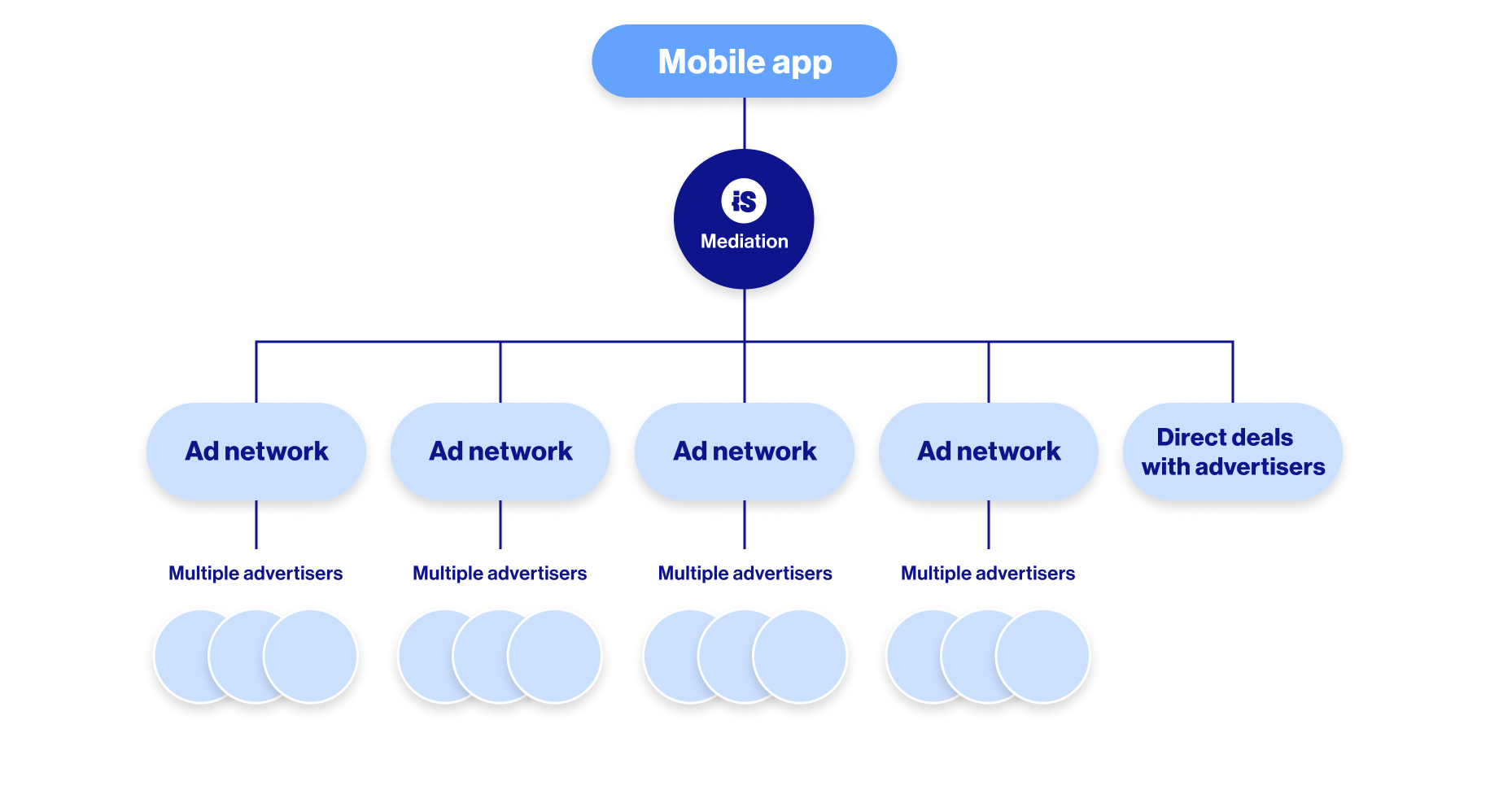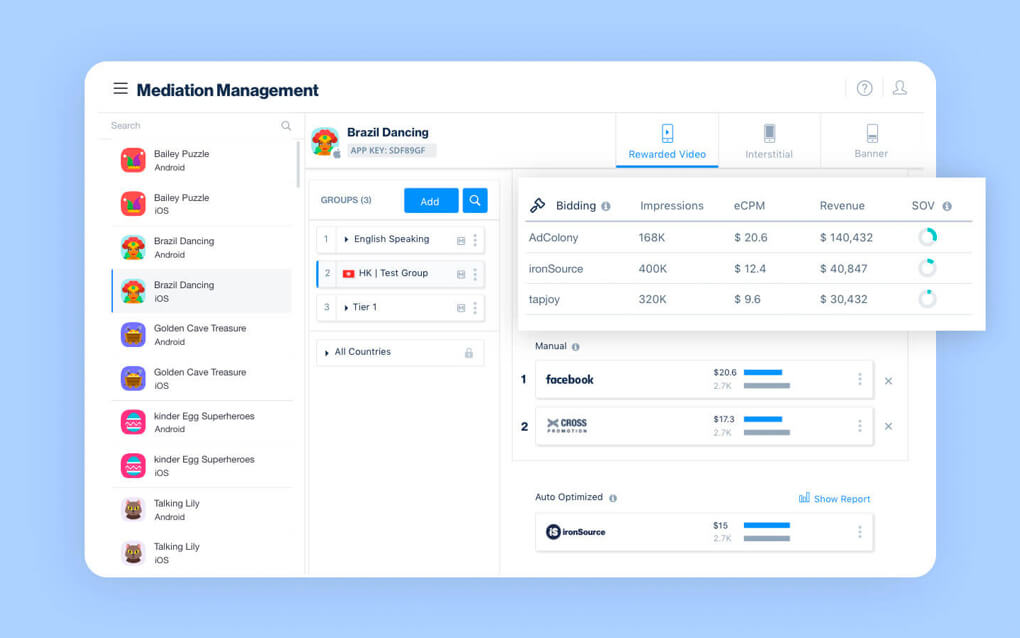Mobile ad mediation: What is it and how does it help app developers?
Mobile ad mediation platforms
If you’re looking to monetize your game through ads, you’ve likely come across the term "mobile ad mediation." By the end of this article, you’ll understand everything you need to know about ad mediation and how it works.
What is mobile ad mediation?
Most mobile game developers today use ads, or a combination of ads and in-app purchases, to monetize their content and turn their games into profitable businesses. To monetize with ads, you need to work with ad networks, which connect you with advertisers looking to acquire new users.
It’s best practice to work with multiple ad networks - more ad networks means more opportunities to fill your ad requests with the right ads, which means more opportunities to make money. However, each ad network requires its own SDK integration, and too many SDKs in your app can slow it down and create a lot of manual overhead to maintain. You would need to find a way to evaluate the performance of each network’s ads in real-time, and decide which one of them will be chosen to fill your available ad slot. Scaling this process is very tricky.
Mediation platforms centralize multiple ad networks in just one platform and manage your monetization operations through a single dashboard. You can then turn different ad networks on and off inside your mediation dashboard at the click of a button.

But that’s not all they do - the best mediation platforms today also offer a variety of sophisticated optimization tools to maximize your revenue, such as in-app bidding and A/B testing. Check out the top fetures every mediation solution should have.
Who uses mobile ad mediation?
The short answer, app developers.
The long answer, app developers who are looking to leverage ad inventory from several ad networks so they can better optimize revenue generated from their app.
How does mobile ad mediation work?
The top mediation platforms today leverage in-app bidding technology to manage the monetization process. The in-app bidding ad serving model works like an auction, and asks all the ad networks at the same time how much they’re willing to pay to serve the ad. The ad network that bids the highest wins the auction and gets to serve the ad.
In-app bidding setups today are often combined with traditional waterfalls. Such hybrid systems are beneficial for developers because they provide access to both network bidders and high quality networks that only operate waterfalls. In essence, this maximizes the number of ad networks competing to fill your ad requests, in turn maximizing the revenue you make - so make sure you can access strong hybrid setups through your mediation platform.

Why is mobile ad mediation important for app developers?
Partnering with the right mediation platform will transform your ability to create a successful games business. Below, we explain the key advantages you can leverage with a great mediation platform.
1. Ad media platform: Maximize ad revenue and eCPMs
Through in-app bidding technology, ad mediation platforms enable you to maximize your ad revenue - up to 3x in fact. There are three aspects to this - first, stronger competition for every impression means ad networks will bid higher than they usually would in order to outbid their competitors.
Second, because all ad networks have the opportunity to bid to fill your ad request - not just the networks at the top of the waterfall - you never leave potential money on the table.
Finally, with in-app bidding, bids for impressions are received in real time, which is more accurate than the flat eCPMs or historical data used in waterfalls. This ensures you, as the developer, never undersell your impressions.

2. Maximize fill rate
Fill rate is the number of ads the ad network serves (impressions) compared to the number of ads you request (requests). Just because your app requests an ad from a given network, doesn’t necessarily mean it’s going to be served. Perhaps that ad network doesn’t have any interstitial ads to show to a user in South Africa at that moment in time.
But, if you connect to multiple ad networks through a mobile ad mediation platform, there’s a much higher chance that one of the networks will have an ad available to serve to your users - no matter where they’re located. That’s because each ad network is known to have a stronger presence in certain regions. So leveraging several mobile ad networks makes sure you cover all your bases. Fill rate is important because if your fill rate is low, it means you’re not getting the most out of your app’s ad inventory and leaving potential revenue on the table.
3. Reduce SDK bloat
There is such a thing as too many SDKs. Manually managing 4-5 different SDK ad networks can slow down your app and affect performance. The more SDKs in your app, the more unpredictable and inconsistent the app’s user experience will be. Instead, a mediation solution requires just one SDK, aggregating all those ad networks inside it. This saves you coding time and minimizes the SDK bloat that’s so common today.
4. Save time through automation
Not only does mediation save you time integrating multiple SDKs into your app, but it also saves you time looking after and manually managing your ad monetization strategy. Of course, someone should always be keeping an eye on the mediation platform - but if you don’t have the resources to hire a monetization manager, the mediation platform can do all the work for you. Once you’ve set up your bidder networks, there’s little to no technical or manual labor involved. Bottom line - you can focus on game development and improving your product, and let the mediation take care of the nitty gritty monetization part.
5. Access additional solutions that fuel revenue growth
The leading mediation platforms today offer a variety of optimization tools that you can use to fuel your game growth. One such tool is A/B testing. ironSource mediation, for example, offers three different A/B testing tools: the quick bidding test to easily determine if bidding is right for your game, the quick A/B testing tool for optimizing waterfalls, and a robust A/B testing tool for testing changes like capping and pacing of ad placements and new ad placements.
An equally important feature of mediation platforms is easy and accurate reporting: as a developer you want to make sure you’re staying on top of your app’s performance and any changes to your KPIs. The strongest mediation platforms, such as ironSource, make it convenient to navigate through your reporting dashboard, and see all the data you need within a few clicks. Understanding what’s working and what needs improvement is the first step on your journey to maximizing revenue and growing your game over the long-term.
Now you know exactly what ad mediation platforms do, and why they’re so important for growing your game into a profitable, long-term business. The mobile gaming industry is so competitive and dynamic that not taking advantage of the growth products offered by the leading mediation platforms will leave you playing catch up.

